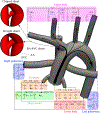The assisted bidirectional Glenn: a novel surgical approach for first-stage single-ventricle heart palliation
- PMID: 25454920
- PMCID: PMC6089632
- DOI: 10.1016/j.jtcvs.2014.10.035
The assisted bidirectional Glenn: a novel surgical approach for first-stage single-ventricle heart palliation
Abstract
Background: Outcomes after a modified Blalock-Taussig shunt (mBTS) in neonates with single-ventricle physiology remain unsatisfactory. However, initial palliation with a superior cavopulmonary connection, such as a bidirectional Glenn (BDG), is discouraged, owing to potential for inadequate pulmonary blood flow (PBF). We tested the feasibility of a novel surgical approach, adopting the engineering concept of an ejector pump, whereby the flow in the BDG is "assisted" by injection of a high-energy flow stream from the systemic circulation.
Methods: Realistic 3-dimensional models of the neonatal mBTS and BDG circulations were created. The "assisted" bidirectional Glenn (ABG) consisted of a shunt between the right innominate artery and the superior vena cava (SVC), with a 1.5-mm clip near the SVC anastomosis to create a Venturi effect. The 3 models were coupled to a validated hydraulic circulation model, and 2 pulmonary vascular resistance (PVR) values (7 and 2.3 Wood units) were simulated.
Results: The ABG provided the highest systemic oxygen saturation and oxygen delivery at both PVR levels. In addition to achieving higher PBF than the BDG, the ABG produced a lower single-ventricular workload than mBTS. SVC pressure was highest in the ABG model (ABG: 15; Glenn: 11; mBTS: 3 mm Hg; PVR = 7 Wood units), but at low PVR, the SVC pressure was significantly lower (ABG: 8; Glenn: 6; mBTS: <3 mm Hg).
Conclusions: Adopting the principle of an ejector pump, with additional flow directed into the SVC in a BDG, the ABG appears to increase PBF with a modest increase in SVC and pulmonary arterial pressure. Although multiscale modeling results demonstrate the conceptual feasibility of the ABG circulation, further technical refinement and investigations are necessary, especially in an appropriate animal model.
Copyright © 2015 The American Association for Thoracic Surgery. Published by Elsevier Inc. All rights reserved.
Figures




Comment in
-
The steam locomotive makes a comeback: a new solution to staged single-ventricle palliation?J Thorac Cardiovasc Surg. 2015 Mar;149(3):706-7. doi: 10.1016/j.jtcvs.2014.11.064. Epub 2014 Nov 27. J Thorac Cardiovasc Surg. 2015. PMID: 25630859 No abstract available.
Similar articles
-
Optimization of the Assisted Bidirectional Glenn Procedure for First Stage Single Ventricle Repair.World J Pediatr Congenit Heart Surg. 2018 Mar;9(2):157-170. doi: 10.1177/2150135117745026. World J Pediatr Congenit Heart Surg. 2018. PMID: 29544408 Free PMC article.
-
An Efficient Assisted Bidirectional Glenn Design With Lowered Superior Vena Cava Pressure for Stage-One Single Ventricle Patients.J Biomech Eng. 2021 Jul 1;143(7):071008. doi: 10.1115/1.4050170. J Biomech Eng. 2021. PMID: 33590839
-
In Vitro Assessment of the Assisted Bidirectional Glenn Procedure for Stage One Single Ventricle Repair.Cardiovasc Eng Technol. 2015 Sep;6(3):256-67. doi: 10.1007/s13239-015-0232-z. Epub 2015 Jul 14. Cardiovasc Eng Technol. 2015. PMID: 26577359
-
Additional pulmonary blood flow has no adverse effect on outcome after bidirectional cavopulmonary anastomosis.Ann Thorac Surg. 2005 Jan;79(1):29-36; discussion 36-7. doi: 10.1016/j.athoracsur.2004.06.002. Ann Thorac Surg. 2005. PMID: 15620909 Review.
-
Extracardiac Fontan operation without cardiopulmonary bypass.J Cardiovasc Surg (Torino). 2006 Dec;47(6):699-704. J Cardiovasc Surg (Torino). 2006. PMID: 17043618 Review.
Cited by
-
In vitro validation of a self-driving aortic-turbine venous-assist device for Fontan patients.J Thorac Cardiovasc Surg. 2018 Jul;156(1):292-301.e7. doi: 10.1016/j.jtcvs.2018.02.088. Epub 2018 Mar 11. J Thorac Cardiovasc Surg. 2018. PMID: 29666009 Free PMC article.
-
The Nutritional Status of Pediatric Patients with Single Ventricle Undergoing a Bidirectional Glenn Procedure.Pediatr Cardiol. 2020 Dec;41(8):1594-1600. doi: 10.1007/s00246-020-02416-w. Epub 2020 Jul 22. Pediatr Cardiol. 2020. PMID: 32700035 Free PMC article.
-
A time-consistent stabilized finite element method for fluids with applications to hemodynamics.Sci Rep. 2023 Nov 5;13(1):19120. doi: 10.1038/s41598-023-46316-4. Sci Rep. 2023. PMID: 37926732 Free PMC article.
-
Computational modeling and engineering in pediatric and congenital heart disease.Curr Opin Pediatr. 2015 Oct;27(5):587-96. doi: 10.1097/MOP.0000000000000269. Curr Opin Pediatr. 2015. PMID: 26262579 Free PMC article. Review.
-
In-Silico and In-Vitro Analysis of the Novel Hybrid Comprehensive Stage II Operation for Single Ventricle Circulation.Bioengineering (Basel). 2023 Jan 19;10(2):135. doi: 10.3390/bioengineering10020135. Bioengineering (Basel). 2023. PMID: 36829630 Free PMC article.
References
-
- Norwood W, Kirklin J, Sanders S. Hypoplastic left heart syndrome: experience with palliative surgery. Am J Cardiol. 1980;45:87–91. - PubMed
-
- Norwood W, Lang P, Castaneda A, Campbell D. Experience with operations for hypoplastic left heart syndrome. J Thorac Cardiovasc Surg. 1981;82:511–9. - PubMed
-
- Wong R, Baum V, Sangwan S. Truncus arteriosus: recognition and therapy of intra-operative cardiac ischemia. Anesthesiology. 1991;74:378–80. - PubMed
-
- Bartram U, Grnenfelder J, Praagh RV. Causes of death after the modified Norwood procedure: a study of 122 postmortem cases. Ann Thorac Surg. 1997;64:1795–802. - PubMed
-
- Tamisier D, Vouhe P, Vernant F, Leca F, Massot C, Neveux J. Modified Blalock-Taussig shunts: results in infants less than 3 months of age. Ann Thorac Surg. 1990;49:797–801. - PubMed
Publication types
MeSH terms
Grants and funding
LinkOut - more resources
Full Text Sources
Other Literature Sources
Medical
Research Materials

